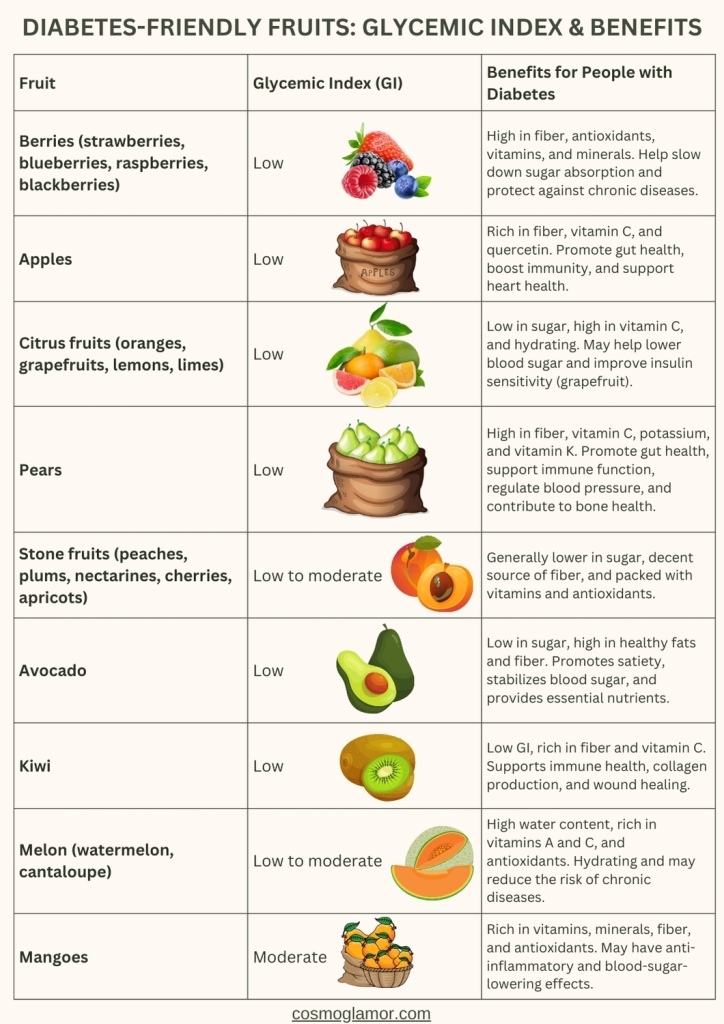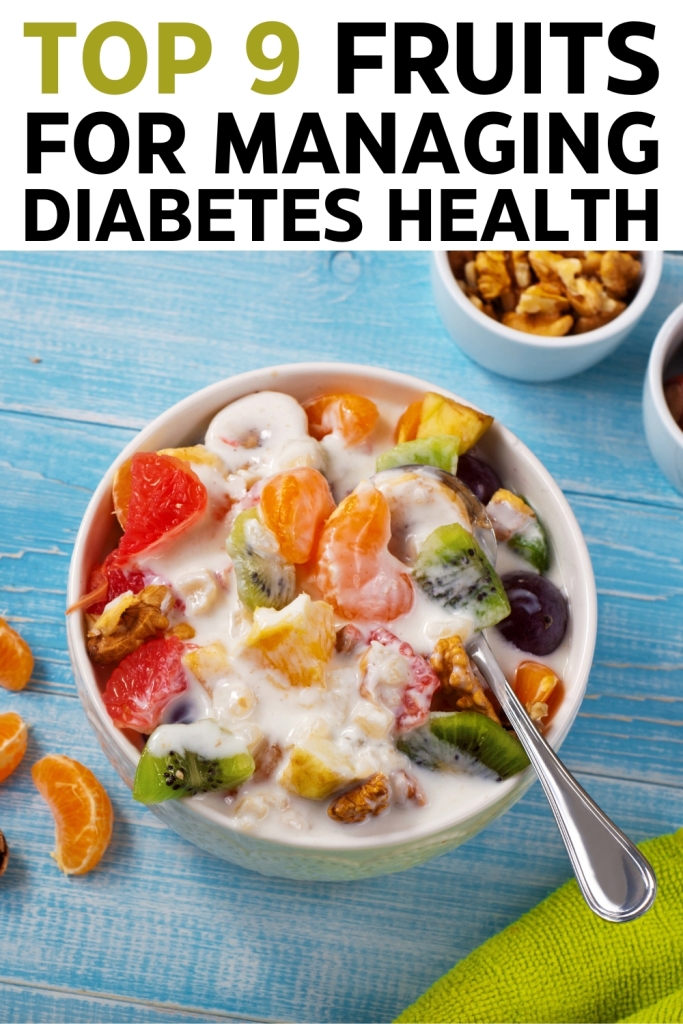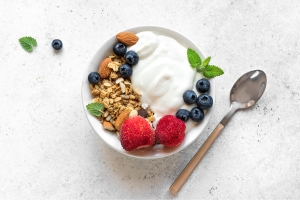Living with diabetes doesn't mean giving up on the sweetness of life. In fact, many fruits offer a delightful way to satisfy your cravings while keeping your blood sugar levels in check. It's all about making informed choices and understanding the balance of sugar and nutrients in each fruit. So, let's embark on a journey through a vibrant orchard of fruits that are not only delicious but also beneficial for those managing diabetes.
The Sweet and Sour Truth About Fruit and Diabetes
While fruits are undeniably delicious and packed with essential nutrients, they also contain natural sugars, primarily fructose and glucose. For individuals with diabetes, managing blood sugar levels is crucial,which requires careful consideration of their fruit choices.
The key lies in understanding the glycemic index (GI) and glycemic load (GL). The GI measures how quickly a particular food raises blood sugar levels. Fruits with a low GI are digested and absorbed slowly, resulting in a gradual increase in blood sugar. These fruits are generally considered safer for people with diabetes. High GI fruits, on the other hand, cause a rapid spike in blood sugar levels, which can be problematic for those managing diabetes.
However, the GI is just one piece of the puzzle. The glycemic load (GL) takes into account both the GI and the amount of carbohydrates in a serving of food. A food with a high GI but a small serving size may have a low GL, and vice versa. Therefore, it's essential to consider both the GI and GL when making fruit choices.
Another crucial factor is the fiber content of the fruit. Fiber slows down the absorption of sugar into the bloodstream, helping to prevent blood sugar spikes. Fruits rich in fiber are particularly beneficial for people with diabetes.
So, can people with diabetes enjoy fruits? Absolutely! The key is to choose wisely, opting for low GI and low GL fruits in moderate portions, and prioritizing those high in fiber. Monitoring blood sugar levels regularly is also essential to track how different fruits affect your body.
Remember:
- Portion control is key: Even low GI fruits can raise blood sugar levels if consumed in large quantities. Stick to recommended serving sizes.
- Pair fruits with protein or healthy fats: This can help slow down the absorption of sugar and prevent blood sugar spikes.
- Choose whole fruits over fruit juice: Fruit juice is often concentrated and lacks the fiber found in whole fruits, leading to a faster rise in blood sugar.
- Variety is important: Include a variety of fruits in your diet to get a wide range of nutrients.
- Consult a healthcare professional: They can provide personalized guidance on fruit intake and other dietary considerations to help you manage your diabetes effectively.
By incorporating fruits into a balanced diet and making informed choices, individuals with diabetes can savor the sweetness of nature without compromising their health.
9 Diabetes-Friendly Fruits: Your Guide to Sweet and Healthy Choices

Berries: Tiny Powerhouses of Goodness

When it comes to fruits that are both delicious and diabetes-friendly, berries reign supreme. These little gems are packed with antioxidants, vitamins, minerals, and fiber, all while boasting a low glycemic index.
Strawberries, blueberries, raspberries, and blackberries are all excellent choices. They're not only low in sugar but also high in fiber, which helps slow down the absorption of sugar into the bloodstream. This means you can enjoy their sweetness without worrying about a sudden blood sugar spike.
Berries are also rich in antioxidants, which help protect your cells from damage caused by free radicals. These powerful compounds have been linked to a reduced risk of heart disease, cancer, and other chronic diseases.
So, how can you incorporate more berries into your diet? The possibilities are endless!
- Add a handful of berries to your morning yogurt or oatmeal.
- Blend them into a smoothie for a refreshing and nutritious snack.
- Toss them into a salad for a burst of flavor and color
- Enjoy them on their own as a guilt-free dessert.
Remember: Frozen berries are just as nutritious as fresh ones and can be a convenient option when fresh berries are not in season. Just be sure to choose unsweetened varieties.
With their vibrant colors, sweet taste, and impressive nutritional profile, berries are a true superfood for people with diabetes. So go ahead and indulge in these tiny powerhouses of goodness!
Apples: A Crisp and Crunchy Delight

While an apple a day might not keep every doctor away, it's certainly a wise choice for people with diabetes, especially for those with diabetes. Apples are a fantastic fruit choice, offering a satisfying crunch and a burst of sweetness, all while being low on the glycemic index.
What makes apples so special for people with diabetes?
- Fiber Powerhouses: One medium apple packs around 4 grams of fiber, which helps slow down the absorption of sugar into the bloodstream. This means a more gradual rise in blood sugar levels, making them a safer choice than many other fruits
- Vitamin C Boost: Apples are a good source of vitamin C, an antioxidant that helps protect your cells and boost your immune system.
- Quercetin: This flavonoid found in apples has been linked to improved heart health and blood sugar control
- Variety is the Spice of Life: With countless varieties like Granny Smith, Fuji, Honeycrisp, and Gala, you can find an apple to suit your taste preferences.
So, how can you incorporate more apples into your diabetes-friendly diet?
- Snack Smart: An apple with a tablespoon of nut butter makes for a filling and nutritious snack that won't spike your blood sugar.
- Salad Star: Add diced apples to your salads for a touch of sweetness and crunch.
- Baked Goodness: Try baked apples with a sprinkle of cinnamon for a warm and comforting dessert.
- Apple Cider Vinegar: Some studies suggest that apple cider vinegar may help improve blood sugar control. Consider adding a tablespoon to a glass of water before meals.
Remember: It's always best to eat the apple with its skin on, as that's where a lot of the fiber and nutrients are concentrated. So next time you're craving a sweet and healthy snack, reach for an apple and enjoy its crisp, crunchy goodness!
Citrus Fruits: Zesty and Refreshing

Citrus fruits like oranges, grapefruits, lemons, and limes bring a burst of sunshine to your plate, and they're a welcome addition to a diabetes-friendly diet. Their tangy flavor and low glycemic index make them a refreshing and healthy choice.
So, what makes citrus fruits a good pick for people with diabetes?
- Low in Sugar, High in Vitamin C: Citrus fruits are naturally low in sugar and packed with vitamin C, a powerful antioxidant that supports immune health and collagen production.
- Naringenin: Found in grapefruits, this flavonoid has been shown to have potential blood-sugar-lowering effects and may improve insulin sensitivity.
- Fiber-Rich: The fiber in citrus fruits, especially when you eat the whole fruit including the pith, can help slow down the absorption of sugar into your bloodstream, promoting stable blood sugar levels
- Hydrating: With their high water content, citrus fruits help keep you hydrated, which is crucial for overall health and can even help manage blood sugar levels.
How can you enjoy citrus fruits while managing diabetes?
- Snack on Whole Fruits: Enjoy a whole orange or grapefruit as a snack. Remember, the whole fruit is better than just the juice, as it retains the beneficial fiber.
- Zest it Up: Add a squeeze of lemon or lime to your water, salads, or grilled fish for a flavor boost without added sugar.
- Grapefruit for Breakfast: Start your day with half a grapefruit or a small glass of grapefruit juice to potentially benefit from its blood-sugar-lowering effects.
Remember: If you're taking any medications, it's crucial to check with your doctor or pharmacist before consuming grapefruit or grapefruit juice, as they can interact with certain medications.
Citrus fruits offer a delicious and nutritious way to add zest to your diabetes-friendly diet. So go ahead, embrace their tangy goodness and reap the health benefits!
Pears: A Sweet and Fiber-Rich Treat

If you're looking for a fruit that's both satisfyingly sweet and packed with fiber, pears are an excellent choice. Their delicate flavor and smooth texture make them a delightful addition to any diabetes-friendly diet.
So, what makes pears a smart choice for managing blood sugar?
- Fiber Power: A medium-sized pear boasts about 6 grams of fiber, which helps slow down the absorption of sugar into your bloodstream. This means you can enjoy their natural sweetness without worrying about a sudden blood sugar spike.
- Low Glycemic Index: Pears have a low glycemic index, which further contributes to their blood-sugar-friendly nature.
- Vitamins and Minerals: Pears are a good source of vitamin C, potassium, and vitamin K. These nutrients play vital roles in immune function, blood pressure regulation, and bone health, respectively
- Versatility: Pears are incredibly versatile. You can enjoy them fresh, poached, baked, or even grilled!
Wondering how to add more pears to your diet?
- Snack Time: Slice up a pear and enjoy it with a handful of almonds for a balanced and satisfying snack
- Salad Addition: Add diced pears to your salads for a touch of sweetness and a boost of fiber.
- Poached Pears: Poach pears in red wine or spiced water for a sophisticated and healthy dessert.
- Smoothie Ingredient: Blend pears into your smoothies for a creamy texture and natural sweetness.
Remember: Choose pears that are ripe but still firm to the touch. As they ripen, their sweetness and texture improve.
So, whether you prefer them crisp and juicy or soft and mellow, pears are a delicious and nutritious way to satisfy your sweet tooth while keeping your blood sugar in check.
Stone Fruits: Juicy Gems of Summer

Stone fruits, with their fleshy exteriors and a single, hard pit at their center, are synonymous with the warmth and sunshine of summer. Peaches, plums, nectarines, cherries, and apricots fall into this category, and they offer a delightful mix of sweetness and nutrients, making them suitable additions to a diabetes-friendly diet.
What makes stone fruits a good choice for people with diabetes?
- Lower Sugar Content: Compared to some other fruits, stone fruits generally have a lower sugar content, making them less likely to cause significant blood sugar spikes.
- Fiber-Rich: Most stone fruits are a decent source of fiber, which helps slow down the absorption of sugar and promotes feelings of fullness.
- Vitamins and Antioxidants: These fruits are packed with vitamins like vitamin C and A, as well as antioxidants that help protect your cells from damage.
- Variety of Flavors and Textures: From the fuzzy skin of a peach to the smooth exterior of a plum, each stone fruit offers a unique taste and texture to enjoy.
How can you include more stone fruits in your diet?
- Fresh and Simple: Enjoy them on their own as a refreshing snack.
- Grilled Delights: Grilling stone fruits like peaches or plums brings out their natural sweetness and adds a smoky char.
- Salad Additions: Add sliced stone fruits to your salads for a burst of color and flavor
- Smoothie Boost: Blend them into smoothies for a creamy and nutritious treat.
Remember: Choose stone fruits that are ripe but not overly soft. They should yield slightly to gentle pressure. Also, be mindful of portion sizes, as even low-sugar fruits can impact blood sugar levels if consumed in excess.
Stone fruits not only tantalize your taste buds but also offer a wealth of health benefits. So, embrace the flavors of summer and indulge in these juicy gems!
Avocado: The Creamy Exception

While most fruits are known for their sweetness, the avocado stands out as a creamy, savory exception. And guess what? It's a fantastic option for people with diabetes.
So, what makes avocados a unique choice for managing blood sugar?
- Low in Sugar, High in Healthy Fats: Avocados are remarkably low in sugar and packed with healthy monounsaturated fats. These fats help you feel full and satisfied, which can prevent overeating and blood sugar spikes.
- Fiber-Rich: A single avocado contains a whopping 10 grams of fiber, further contributing to stable blood sugar levels and promoting digestive health
- Nutrient Powerhouse: Avocados are a rich source of potassium, folate, and vitamins K, C, and E. These nutrients are essential for heart health, cell function, and immune support
- Versatile Ingredient: From guacamole to salads to toast toppings, avocados can be enjoyed in countless ways.
How can you include more avocados in your diabetes-friendly diet?
- Guacamole: Whip up a batch of guacamole with ripe avocados, lime juice, cilantro, and a touch of salt and pepper. Enjoy it with whole-grain chips or veggie sticks.
- Salad Topper: Dice or slice avocado and add it to your salads for a creamy texture and healthy fats.
- Toast Upgrade: Spread mashed avocado on whole-grain toast and top it with a poached egg or smoked salmon for a satisfying breakfast or lunch
- Smoothie Addition: Blend avocado into your smoothies for a creamy texture and a boost of nutrients
Remember: Avocados are a calorie-dense fruit, so be mindful of portion sizes. A quarter to half an avocado is usually a good serving size for people with diabetes.
So, don't hesitate to embrace the creamy goodness of avocados. They're a delicious and nutritious way to add healthy fats and fiber to your diet while keeping your blood sugar in check.
Kiwi: The Tropical Treat

Don't let its fuzzy exterior fool you! The kiwi, with its vibrant green flesh and tiny black seeds, is a nutritional powerhouse that's surprisingly diabetes-friendly. It offers a unique combination of sweetness and tanginess, along with a host of health benefits.
So, why should kiwis be on your radar if you have diabetes?
- Low Glycemic Index: Kiwis have a low glycemic index, meaning they won't cause a rapid spike in your blood sugar levels.
- Fiber-Rich: One kiwi packs about 2 grams of fiber, helping to slow down the absorption of sugar and keep you feeling full and satisfied.
- Vitamin C Champion: Kiwis are an excellent source of vitamin C, even surpassing oranges in this regard. Vitamin C is crucial for immune health, collagen production, and wound healing.
- Other Nutrients: Kiwis also contain vitamin K, potassium, and folate, all of which play vital roles in overall health.
How can you enjoy kiwis while managing diabetes?
- Eat them Whole: The simplest way to enjoy a kiwi is to cut it in half and scoop out the flesh with a spoon. The tiny seeds are edible and add a nice crunch
- Fruit Salad Star: Add sliced kiwis to your fruit salads for a tropical twist
- Smoothie Booster: Blend kiwis into your smoothies for a refreshing flavor and a boost of vitamin C
- Salsa Surprise: Try adding diced kiwi to your salsa for a unique and tangy flavor combination
Remember: Choose kiwis that are slightly soft to the touch, as this indicates they're ripe and ready to eat. If they're too hard, let them ripen at room temperature for a few days.
With their vibrant color, refreshing taste, and impressive nutritional profile, kiwis are a delightful and healthy addition to any diabetes-friendly diet. So, go ahead and add a touch of the tropics to your plate!
Melon: A Refreshing Summer Delight

When the summer heat hits, there's nothing quite like a juicy slice of melon to cool you down. But did you know that certain melons can also be a refreshing and healthy addition to a diabetes-friendly diet?
So, which melons are the best options for people with diabetes?
- Watermelon and Cantaloupe: These melons are particularly good choices as they have a lower glycemic index compared to other varieties. This means they won't cause a rapid spike in your blood sugar levels.
- Honeydew and Casaba: While slightly higher on the glycemic index, these melons can still be enjoyed in moderation as part of a balanced diet.
What makes melons a good choice for people with diabetes?
- High Water Content: Melons are incredibly hydrating, which is crucial for overall health and can even aid in blood sugar management.
- Vitamins and Antioxidants: They are packed with vitamins A and C, as well as antioxidants like lycopene, which has been linked to a reduced risk of heart disease and some types of cancer
- Low in Calories: Melons are generally low in calories, making them a guilt-free way to satisfy your sweet tooth.
How can you include more melon in your diet?
- Simple Snack: Enjoy a bowl of cubed melon as a refreshing and hydrating snack.
- Salad Addition: Add melon balls or cubes to your salads for a burst of sweetness and color
- Smoothie Ingredient: Blend melon into your smoothies for a refreshing flavor and a boost of vitamins.
- Frozen Treat: Freeze melon chunks for a healthy and refreshing frozen dessert.
Remember: It's always best to choose melons that are ripe and juicy. Look for melons that feel heavy for their size and have a sweet aroma.
With their high water content, refreshing taste, and beneficial nutrients, melons are a delightful way to stay hydrated and satisfied while managing diabetes. So, embrace the sweetness of summer and enjoy these juicy delights!
Mangoes: Tropical Sweetness with a Twist

While mangoes are undeniably sweet and luscious, they can still have a place in a diabetes-friendly diet when enjoyed mindfully. These golden orbs pack a powerful nutritional punch and offer a unique flavor experience that's hard to resist.
So, what makes mangoes a worthwhile addition for those with diabetes?
- Rich in Vitamins and Minerals: Mangoes are a fantastic source of vitamins A and C, as well as potassium and folate. These nutrients play a key role in vision, immune health, and cell function.
- Fiber Content: A medium-sized mango contains around 3 grams of fiber, which helps slow down sugar absorption and promotes digestive health.
- Antioxidants: Mangoes are rich in antioxidants like mangiferin, which has been studied for its potential anti-inflammatory and blood-sugar-lowering effects.
- Exotic Flavor: The unique, tropical flavor of mangoes can add a delightful twist to your meals and snacks.
How can you enjoy mangoes while managing your blood sugar?
- Portion Control is Key: Mangoes are naturally sweet, so be mindful of portion sizes. A half or one-third of a mango is typically a suitable serving for people with diabetes.
- Pair with Protein or Fats: Combining mangoes with protein sources like Greek yogurt or healthy fats like nuts can help slow down sugar absorption.
- Smoothie Star: Add mango chunks to your smoothies for a tropical twist and a dose of vitamins
- Salsa Sensation: Mango salsa, with its blend of sweet and savory flavors, makes a great accompaniment to grilled chicken or fish.
Remember: Choose mangoes that yield slightly to gentle pressure, indicating they're ripe and ready to eat. Avoid overly soft or bruised mangoes.
While mangoes should be consumed in moderation due to their natural sugar content, they offer a wealth of nutrients and a burst of tropical flavor that can be enjoyed as part of a balanced diabetes-friendly diet.
Making Informed Choices: Tips for Fruitful Living
Navigating the world of fruits when you have diabetes might seem a bit tricky at first, but armed with the right knowledge, you can make choices that support your health and satisfy your taste buds. Here are some practical tips to help you embrace a fruitful lifestyle:
- Prioritize Whole Fruits: Opt for whole fruits over fruit juices or dried fruits. Whole fruits retain their natural fiber, which helps slow down sugar absorption and keeps you feeling fuller for longer.
- Monitor Your Blood Sugar: Keep a close eye on your blood sugar levels, especially after consuming fruits. This will help you understand how different fruits affect your body and make adjustments as needed.
- Mindful Portions: Even the most diabetes-friendly fruits can impact your blood sugar if you eat too much. Stick to recommended serving sizes and be mindful of your overall carbohydrate intake.
- Combine with Protein or Healthy Fats: Pairing fruits with protein sources like nuts, seeds, or yogurt, or healthy fats like avocado, can help slow down the absorption of sugar and prevent blood sugar spikes.
- Consult a Registered Dietitian: A registered dietitian can help you create a personalized meal plan that includes fruits in a way that supports your diabetes management goals.
Remember, knowledge is power. The more you understand about the fruits you eat and how they affect your blood sugar, the better equipped you'll be to make informed choices and enjoy a vibrant, fruit-filled life.
Living with diabetes doesn't mean sacrificing the joy of fruits. By being mindful, making informed choices, and embracing a balanced approach, you can savor the sweetness of nature's bounty while staying on top of your health.
Conclusion: Embrace the Sweetness of Life
Managing diabetes doesn't mean saying goodbye to the simple pleasures of life, like enjoying a piece of juicy fruit. In fact, with a little knowledge and mindful choices, fruits can play a delicious and nutritious role in your diabetes management plan. Remember, it's all about finding the balance between sweetness and health.
So go ahead, explore the vibrant world of fruits. Discover new favorites, experiment with different combinations, and most importantly, savor each bite. With a bit of planning and awareness, you can enjoy the sweetness of life while keeping your health in check. Remember, your journey with diabetes is unique, and with the right approach, you can thrive while still indulging in the deliciousness that nature has to offer.








